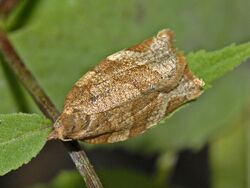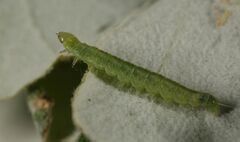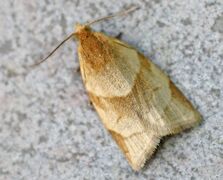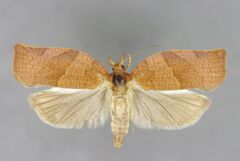Biology:Pandemis heparana
| Pandemis heparana | |
|---|---|

| |
| Scientific classification | |
| Domain: | Eukaryota |
| Kingdom: | Animalia |
| Phylum: | Arthropoda |
| Class: | Insecta |
| Order: | Lepidoptera |
| Family: | Tortricidae |
| Genus: | Pandemis |
| Species: | P. heparana
|
| Binomial name | |
| Pandemis heparana (Denis & Schiffermüller, 1775)[1]
| |
| Synonyms | |
| |
Pandemis heparana, the dark fruit-tree tortrix or apple brown tortrix,[2] is a moth of the family Tortricidae.
Distribution
This species can be found in most of Europe, in the eastern Palearctic realm, in the Near East, [3] and in North America.
Description
Pandemis heparana has a wingspan of 16–24 mm.[4] In these moths the basic color of the forewings ranges from yellowish brown to reddish brown, with a reticulate pattern, a dark brown basal fascia, dark brown transversal bands, two triangular spots and brown fringes at the edge. The hindwings are gray-brown with white-yellow fringes. The larva can reach 22 mm and it is pale green.[5][6]
This species is rather similar to Pandemis cerasana.[4]
Biology
These moths have two generations per year (bivoltine).[5] The moth flies from late May to mid-September in western Europe. The larvae are considered a pest of trees and shrubs.[6] They live in a rolled leaf and are polyphagous, feeding on various deciduous trees and shrubs including oak, willow, birch, honeysuckle, sorbus, apple and pear.[4][6] Pupation takes places in the rolled leaves.[7][5]
Gallery
References
- ↑ Tortricidae.com
- ↑ Apple brown tortrix (Pandemis heparana) at Plantwise Knowledge Bank
- ↑ Fauna europaea
- ↑ 4.0 4.1 4.2 UK Moths
- ↑ 5.0 5.1 5.2 HYPP Zoology
- ↑ 6.0 6.1 6.2 David V Alford Pests of Fruit Crops: A Colour Handbook
- ↑ Lepidoptera of Belgium
External links
Wikidata ☰ Q898337 entry
 |




